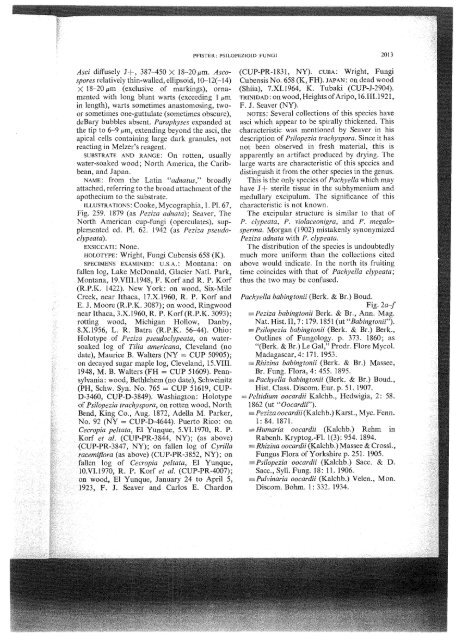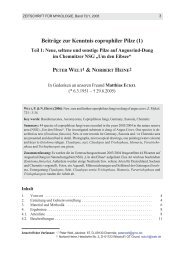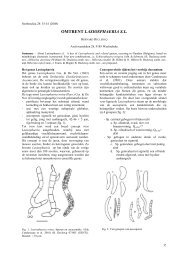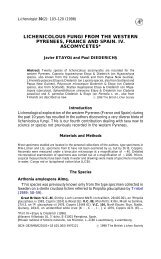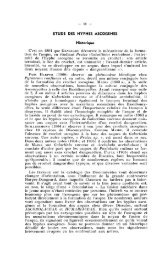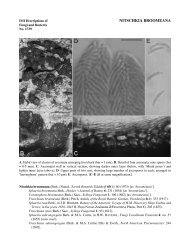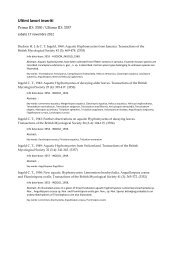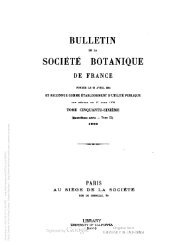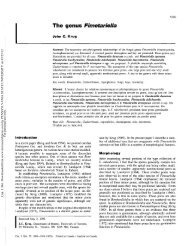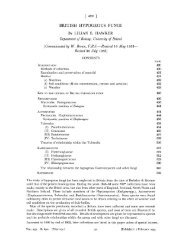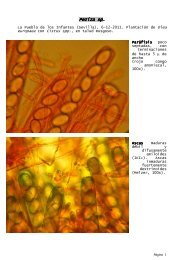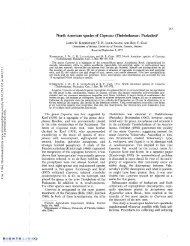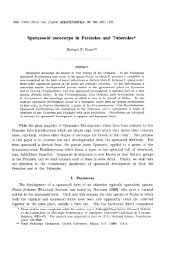Pfister-1973-The-psilopezioid-fungi-IV-Pachyella-0001 - ASCOfrance
Pfister-1973-The-psilopezioid-fungi-IV-Pachyella-0001 - ASCOfrance
Pfister-1973-The-psilopezioid-fungi-IV-Pachyella-0001 - ASCOfrance
You also want an ePaper? Increase the reach of your titles
YUMPU automatically turns print PDFs into web optimized ePapers that Google loves.
Asci diffusely J+, 387-450 x 18-20 pm. Asco-<br />
spores relatively thin-walled, ellipsoid, 10-1 2(- 14)<br />
X 18-20 pm (exclusive of markings), orna-<br />
mented with long blunt warts (exceeding 1 pn1<br />
in length), warts sometimes anastornosing, two-<br />
or sometimes one-guttulate (sometimes obscure),<br />
deBary bubbles absent. Paraphyses expanded at<br />
the tip to 6-9 pm, extending beyond the asci, the<br />
apical cells containing large dark granules, not<br />
reacting in Melzer's reagent.<br />
SUBSTRATE AND RANGE: On rotten, usually<br />
water-soaked wood; North America, the Carib-<br />
bean, and Japan.<br />
NAME: from the Latin 6'adnatus,'' broadly<br />
attached, referring to the broad attachment of the<br />
apothecium to the substrate.<br />
ILLUSTRATIONS: Cooke, Mycographia, 1. PI. 67,<br />
Fig. 259. 1879 (as Peziza adnata); Seaver, <strong>The</strong><br />
North American cup-<strong>fungi</strong> (operculates), sup-<br />
plemented ed. PI. 62. 1942 (as Peziza pseudo-<br />
clypeata).<br />
EXSICCATI : None.<br />
HOLOTYPE: Wright, Fungi Cubensis 658 (K).<br />
SPECIMENS EXAMINED : U.S.A. : Montana : on<br />
fallen log, Lake McDonald, Glacier Natl. Park,<br />
Montana, 19.VIII.1948, F. Korf and R. P. Korf<br />
(R.P.K. 1422). New York: on wood, Six-Mile<br />
Creek, near Ithaca, l7.X. 1960, R. P. Korf and<br />
E. J. Moore (R.P.K. 3087); on wood, Ringwood<br />
near Ithaca, 3 .X. 1960, R. P. Korf (R.P.K. 3093) ;<br />
rotting wood, Michigan Hollow, Danby,<br />
8.X.1956, L. R. Batra (R.P.K. 56-44). Ohio:<br />
Holotype of Peziza pseudoclypeata, on water-<br />
soaked log of Tilia americana, Cleveland (no<br />
date), Maurice B. Walters (NY = CUP 50905);<br />
on decayed sugar maple log, Cleveland, l5.VIII.<br />
1948, M. B. Walters (FH = CUP 51609). Penn-<br />
sylvania: wood, Bethlehem (no date), Schweinitz<br />
(PH, Schw. Syn. No. 765 = CUP 51619, CUP-<br />
D-3460, CUP-D-3849). Washington: Holotype<br />
of Psilopezia trachyspora, on rotten wood, North<br />
Bend, King Co., Aug. 1872, Adella M. Parker,<br />
No. 92 (NY = CUP-D-4644). Puerto Rico: on<br />
Cecropia peltata, El Yunque, 5.VI.1970, R. P.<br />
Korf et al. (CUP-PR-3844, NY); (as above)<br />
(CUP-PR-3847, NY); on fallen log of CyriZla<br />
racemiflora (as above) (CUP-PR-3852, NY) ; on<br />
fallen log of Cecropia peltata, El Yunque,<br />
lO.VI.1970, R. P. Korf et al. (CUP-PR-4007);<br />
on wood, El Yunque, January 24 to April 5,<br />
1923, F. J. Seaver and Carlos E. Chardon<br />
PFISTER: PSILOPEZIOID FUNGI<br />
(CUP-PR- 183 1, NY). CUBA : Wright, Fungi<br />
Cubensis No. 658 (K, FH). JAPAN: on dead wood<br />
(Shiia), 7.X. 1964, K. Tubaki (CUP-J-2904).<br />
TRINIDAD: on wood, Heights of Aripo, 16.111.1921,<br />
F. J. Seaver (NY).<br />
NOTES: Several collections of this species have<br />
asci which appear to be spirally thickened. This<br />
characteristic was mentioned by Seaver in his<br />
description of Psilopezia trachyspora. Since it has<br />
not been observed in fresh material, this is<br />
apparently an artifact produced by drying. <strong>The</strong><br />
large warts are characteristic of this species and<br />
distinguish it from the other species in the genus.<br />
This is the only species of <strong>Pachyella</strong> which may<br />
have J+ sterile tissue in the subhyrnenium and<br />
medullary excipulum. <strong>The</strong> significance of this<br />
characteristic is not known.<br />
<strong>The</strong> excipular structure is similar to that of<br />
P. clypeata, P. violaceonigra, and P. megalosperma.<br />
Morgan (1902) mistakenly synonymized<br />
Peziza adnata with P. clypeata.<br />
<strong>The</strong> distribution of the species is undoubtedly<br />
much more uniform than the collections cited<br />
above would indicate. I11 the north its fruiting<br />
time coincides with that of <strong>Pachyella</strong> clypeata',<br />
thus the two may be confused.<br />
<strong>Pachyella</strong> babingtonii (Berk. & Br.) Boud.<br />
Fig. la-f<br />
== Peziza babingtonii Berk. & Br., Ann. Mag.<br />
Nat. Hist. II,7 : 179. 1851 (ut "Babingtonii").<br />
= Psilopezia babingtonii (Berk. & Br.) Berk.,<br />
Outlines of Fungology. p. 373. 1860; as<br />
"(Berk. & Br.) Le Gal," Prodr. Flore Mycol.<br />
Madagascar, 4: 17 1. 1953.<br />
== Rlzizina babingtonii (Berk. & Br.) Massee,<br />
Br. Fung. Flora, 4: 455. 1895.<br />
=<strong>Pachyella</strong> babingtonii (Berk. & Br.) Boud.,<br />
Hist. Class. Discom. Eur. p. 51. 1907.<br />
= Peltidium oocardii Kalchb., Hedwigia, 2 : 58.<br />
1862 (ut "Oocardii").<br />
== Peziza oocardii(Ka1chb.) Karst., Myc. Fenn.<br />
1: 84. 1871.<br />
= Humaria oocardii (Kalchb.) Rehm in<br />
Rabenh. Kryptog-Fl. l(3): 954. 1894.<br />
Rhizina oocardii (Kalchb.) Massee & Crossl.,<br />
:<br />
Fungus Flora of Yorkshire p. 25 1. 1905.<br />
iPsilopezia oocardii (Kalchb.) Sacc. & D.<br />
Sacc., Syll. Fung. 18 : 11. 1906.<br />
== Pulvinaria oocardii (Kalchb.) Velen., Mon.


